Learn how to make your own homemade deodorant spray. This easy recipe contains antibacterial essential oils that help control body odor naturally. Plus, discover 12 effective essential oil blends for deodorant.
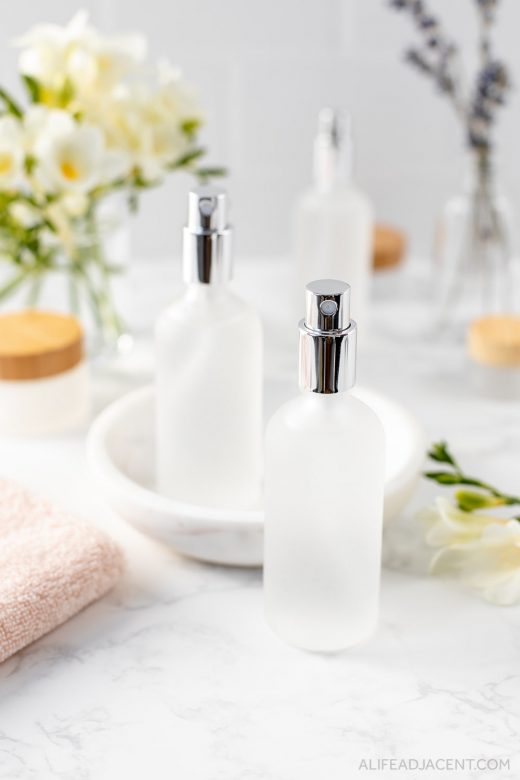
Everyone wants to smell good. Unfortunately, the products we use for a pleasant fragrance often come packaged with some very unpleasant ingredients.
Just take a look at the labels of the most popular deodorants. Even if you aren’t convinced by the possible link between antiperspirants and breast cancer1, there are still plenty of other reasons to avoid commercial deodorant products.
These include parabens, synthetic fragrances, and other potential endocrine disruptors – not to mention the dangerous chemical propellants in deodorant aerosols.
But all of these issues are easily avoided by making your own DIY deodorant spray. And if you think natural or homemade deodorants don’t work for smelly armpits, you likely haven’t used the right kind!
In this post, I’m sharing my easy and effective essential oil deodorant spray recipe. This deodorant really works to keep you smelling fresh. All you need is 3 simple ingredients and essential oils.
This recipe is perfect for those who prefer the convenience and non-greasy feel of liquid deodorants. It’s also made without baking soda to reduce the risk of skin irritation.
Additionally, I’ve included 12 antibacterial essential oil combinations that help combat body odor. Whether your fragrance preference is floral, fruity, or more on the woodsy side, there are options for everyone.
If you’re interested, I’ve also written a companion post where you can find a list of the best essential oils for deodorant supported by evidence.
- What causes body odor?
- How essential oils help control body odor
- What essential oils are good for homemade deodorant?
- The best essential oils for DIY deodorant spray
- Homemade deodorant spray ingredients
- Essential oil combinations for homemade deodorant spray
- DIY Deodorant Spray Recipe
- How to use your deodorant spray
- DIY deodorant spray FAQ
- How much essential oils to add to deodorant
- Are all essential oils good for armpits?
- Can you use witch hazel as a substitute for alcohol?
- Is witch hazel a solubilizer?
- Is vegetable glycerin an emulsifier?
- Can you use rubbing alcohol as deodorant?
- Is it safe to use rubbing alcohol as deodorant?
- Is this deodorant spray suitable for sensitive skin?
What causes body odor?
Before we learn how to make our own deodorant spray, it may be helpful to know – what causes body odor, and how exactly does this recipe help prevent it?
The truth is that sweat itself doesn’t stink. Our body odor isn’t our fault – it’s our bacteria’s.
Our bodies are home to trillions of bacteria, many of which reside in the gut and on our skin. And it’s these skin bacteria that cause the stink. They break down our sweat, transforming it into smelly compounds like thioalcohols that we know as the characteristic scent of BO2.
With this in mind, improving body odor isn’t complicated; it’s simply about reducing the odor-causing bacteria on your skin. And using a DIY deodorant spray with essential oils can help!
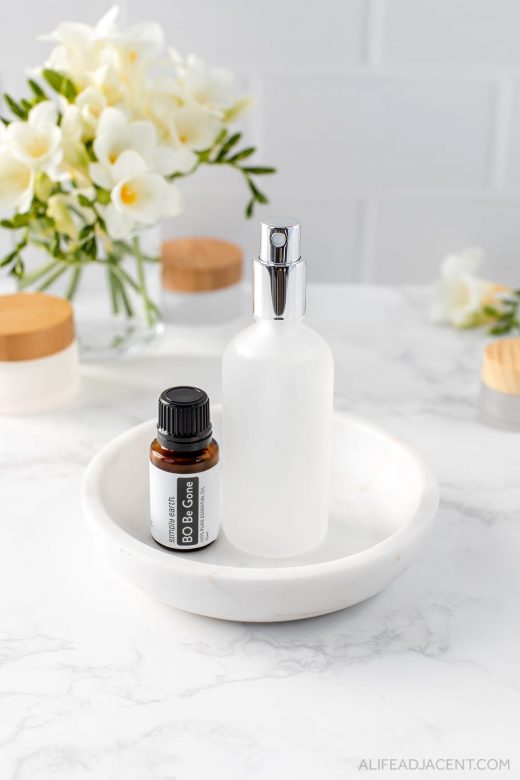
How essential oils help control body odor
When it comes to controlling body odor, essential oils are useful for a variety of reasons – the most obvious being their pleasant scent.
But aside from masking the smell, essential oils can actually help kill the bacteria that cause body odor in the first place. Some EOs have even been studied specifically for their odor-controlling properties3.
That’s right – some essential oils have actually been proven to work for smelly armpits, and this wasn’t just made up by essential oil enthusiasts!
Of all the essential oils commonly used to prevent perspiration odor, there’s one blend in particular that I find especially useful.
What essential oils are good for homemade deodorant?
One of my favourite essential oil blends for deodorant is Simply Earth’s BO Be Gone, a potent combination of patchouli, ylang-ylang, sandalwood, lavender, and sweet orange that can help reduce body odor naturally.
This blend works exceptionally well for smelly armpits and sweaty odors of any kind. One reviewer said it even helped get the stink out of smelly athletic clothes.
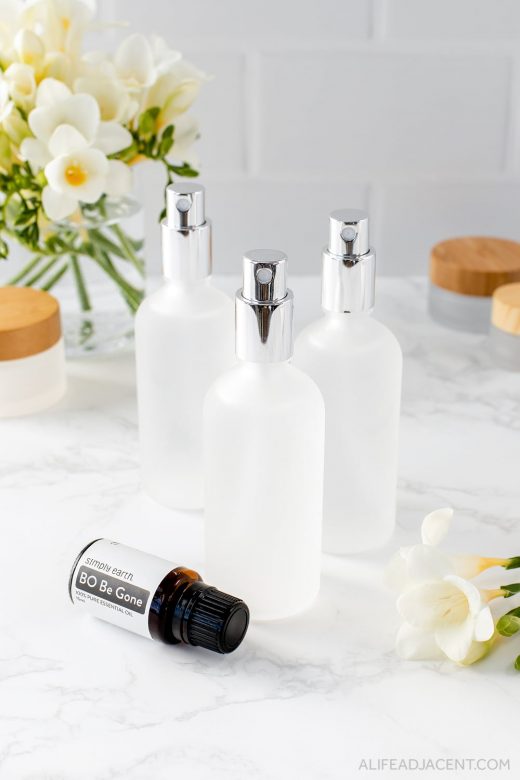
After doing some research, I found some interesting evidence that helps explain why it’s so effective as deodorant.
- Patchouli essential oil has been shown to inhibit a wide variety of bacteria, including those that directly cause body odor. These include several from the Staphylococcus genus: S. hominis, S. epidermidis and S. haemolyticus4. Patchouli can also be combined with other oils for even more potent antibacterial effects5.
- Ylang-ylang essential oil on its own has been found to be particularly effective against S. hominis, one of the main bacteria linked to perspiration odor4. As well, a mixture of lavender oil, clary sage oil, and ylang ylang oil was found to be effective against an even wider variety of pathogenic bacteria6.
- Sandalwood essential oil has shown antibacterial activity against many gram-positive bacteria associated with body odor, including S. hominis4 and S. epidermidis7. Additionally, in a study of antibacterial essential oil blends, sandalwood and patchouli were identified as contributing some of the strongest antibacterial activity5.
- Lavender essential oil is effective against many of the smelly bacteria on our skin, including the odor-producing Staphylococcus species8. Its calming aroma can also help decrease excessive sweating (hyperhydrosis) caused by stress.
- Sweet orange essential oil is reported to inhibit the growth of many different kinds of bacteria and fungi, including S. aureus, another bacteria that can cause unpleasant odor9.
As you can see, it makes sense why this particular blend works so well for odors!
BO Be Gone has a mellow, pleasant scent that works well for both women and men. Its notes of patchouli and sandalwood are balanced nicely by lavender and ylang-ylang, so the result isn’t overpowering. It’s also offered in a convenient roll-on formula.
Another benefit is how long this fragrance lasts – it’s one of those blends you can smell all day long. This makes sense, as patchouli, sandalwood and ylang-ylang are all long-lasting base note oils.
(On a side note, when I use a couple drops in my oil warmer, the scent lasts for over a week. That’s how potent this stuff is.)
If you’re not into BO Be Gone, Timber is another effective blend for body odor. It’s an intoxicating combination of cypress, patchouli, cedarwood, peru balsam, mandarin, and sandalwood. However, this woodsy blend is more on the masculine side and may be better suited to a men’s deodorant spray.
If neither of these blends appeal to you, there are still plenty of other choices. Most (if not all) essential oils posses some degree of antibacterial activity. Some are simply more potent than others.
Some of the best antibacterial essential oils for deodorant include:
- Amyris
- Camphor
- Cedarwood
- Fir
- Juniper Berry
- Lavender
- Lemon
- Lemongrass
- Oregano
- Patchouli
- Rosemary
- Sandalwood
- Tea Tree
- Thyme
- Ylang-ylang
Please note that this is by no means an exhaustive list. For more options, you can read my comprehensive post on the best essential oils for body odor.
If you need more ideas, keep reading for 12 deodorant essential oil blends.
The best essential oils for DIY deodorant spray
I’ve been making my own deodorant for a long time, but our latest essential oil subscription box inspired me to share some of my recipes.
You may have seen us mention Simply Earth on this blog before. If you didn’t already know, the Simply Earth Essential Oil Recipe Box is a monthly subscription box that contains 4 full-size essential oils at a very affordable price.
Each box has a theme, and the January 2021 box is all about personal hygiene. It includes BO Be Gone, the blend I mentioned earlier, as well as large bottles of lemon, ylang-ylang, and camphor essential oils.
All four oils possess antibacterial properties that make them great choices to incorporate into a DIY deodorant spray.

But each box includes more than essential oils – Simply Earth also provides 6 recipes and the materials to make them. For instance, January’s box includes:
- A natural deodorant stick recipe with all the required ingredients, including zinc oxide
- A BO Emergency essential oil roll-on to tackle body odor on the go
And much more! You can see the current box’s full contents here.
If you sign up for their monthly box, you’ll receive their Big Bonus Box for FREE (a $44.84 value) with your subscription.
One more thing – if you subscribe using our link and coupon code, ALIFEADJACENTFREE, you will also receive a $40 gift card with your initial box!
For more information, see our full Simply Earth Essential Oils review. Now, let’s get into the ingredients for this easy recipe.
Homemade deodorant spray ingredients
To make your own deodorant spray, you will need:
- Essential oils. As previously mentioned, essential oils add a pleasant natural fragrance while helping to keep body odor at bay.
- Alcohol. High-proof grain alcohol (or vodka) creates a non-greasy deodorant base that won’t stain clothes.
- Glycerin. Alcohol can be drying to skin, so vegetable glycerin helps prevent dry armpits.
- Apple cider vinegar. Vinegar lowers your skin’s pH, which can help reduce underarm odor. However, it’s optional.
- Solubilizer. This is optional, and only required if you don’t have access to high-proof vodka.

Alcohol
I used high-proof alcohol as the base for this liquid deodorant spray. Alcohol acts as a natural disinfectant that helps kill the bacteria that cause body odor.
In fact, vodka can even work as an alternative to deodorant when you’re in a pinch. Its antibacterial qualities are also what make high-proof alcohol an effective ingredient in homemade hand sanitizer.
Alcohol is also required to solubilize, or dissolve, the essential oils in your deodorant spray.
According to the Tisserand Institute, you’ll need to use vodka that’s at least 151 proof (75.5% ethanol) for solubilization purposes. This can be a high-proof vodka or a grain alcohol product such as Everclear 151.
If you live in an area where Everclear is available, it’s ideal for this recipe. But if you don’t have access to Everclear, simply use the product with the highest alcohol percentage available in your area.
Other high-proof vodka options include:
- Devil Springs Vodka: 80% alcohol or 160 proof
- Good ol’ Sailor Vodka: 85% vodka or 175 proof
- Balkan 176: 88% alcohol or 176 proof
- Pincer Vodka: 88% alcohol or 176 proof
- Spirytus Rektyfikowany: 96% alcohol or 192 proof
If you don’t have access to a high-proof alcohol, you can use a solubilizer to dissolve your essential oils in regular vodka. More on this in a moment. However, please note that the more alcohol your formula contains, the more effective it will be.
Vegetable glycerin
Products containing alcohol can dry out the skin, especially those that are applied frequently. So, a small amount of vegetable glycerin helps moisturize underarms and prevent skin dryness and cracking.
Apple cider vinegar
Apple cider vinegar is a popular body odor remedy, and for good reason. Evidence suggests that a high underarm pH allows the bacteria that produce body odor to grow10.
But vinegar helps reduce the pH of our underarms, which creates a less hospitable environment for these malodorous bacteria.
However, many deodorant recipes use far too much vinegar! Apple cider vinegar has a pH of about 2-3, which is very acidic and can be irritating to the skin.
You only need a small amount for it to be effective. If desired, you can also use plain white vinegar.
In any case, this ingredient is optional, as high-proof alcohol works well on its own to reduce perspiration odor.

Solubilizer
Essential oils and water do not mix under most circumstances. Unfortunately, many deodorant spray recipes do not account for this.
Without enough alcohol, your essential oils will not completely dissolve in your formula. Instead, they will float on top and and create a puddle of oil. It goes without saying that this does not create an effective deodorant!
So, if you can’t find high-proof alcohol, you’ll require a fragrance solubilizer (or liquid emulsifier) to properly disperse the essential oils in your deodorant spray.
I frequently use and recommend Poly Suga Mulse D9, a natural fragrance solubilizer and gentle surfactant. But Simply Earth also sells their own natural solubilizer (Caprylyl/Capryl Glucoside), so it’s easy get your deodorant ingredients in one place.
An essential oil solubilizer has a variety of uses beyond deodorant spray. So if you’re willing to invest, you can also use it to make any of these recipes:
- DIY Dry Shampoo Spray
- DIY Micellar Water
- Homemade Micellar Water Wipes
- Micellar Cleansing Water for Hair
Essential oil combinations for homemade deodorant spray
Below I’ve included some of the best essential oil blends for deodorant and odor control.
Many antibacterial essential oils such as tea tree and rosemary are frequently touted to reduce body odor. They may work, but they also have herbaceous scents that not everyone enjoys.
For this reason, I’ve also included some more feminine essential oil combinations that work very well in homemade deodorant sprays.
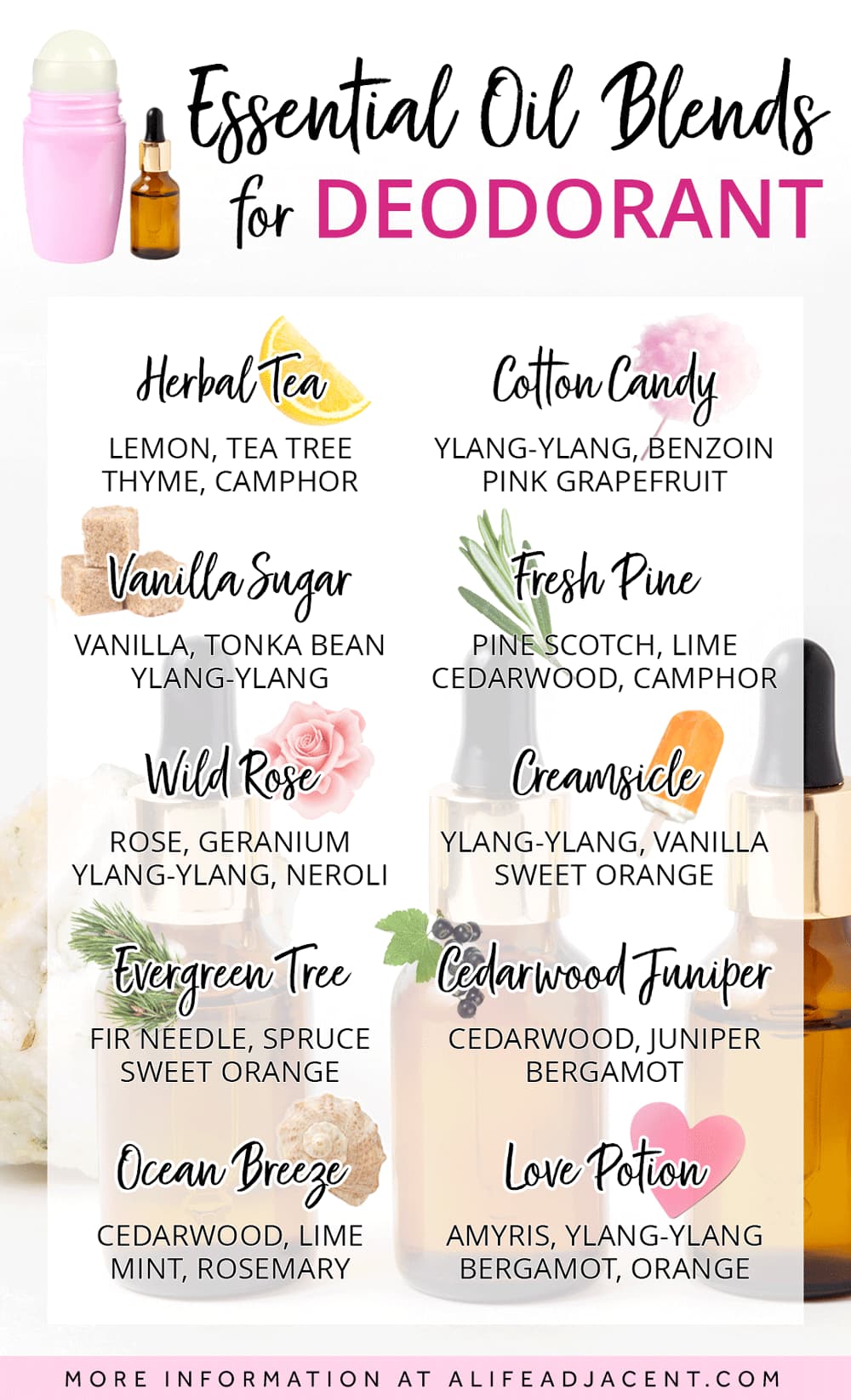
- BO Be Gone: 40 drops BO Be Gone or 10 drops patchouli, 10 drops ylang ylang, 10 drops sweet orange, 5 drops sandalwood, 5 drops lavender
- Timber: 40 drops Timber or 10 drops cypress, 10 drops mandarin, 10 drops Peru balsam, 5 drops patchouli, 5 drops sandalwood
- Herbal Tea: 20 drops lemon, 10 drops tea tree, 5 drops rosemary, 5 drops thyme
- Fresh Pine: 20 drops pine scotch, 10 drops lime, 5 drops cedarwood, 2 drops camphor
- Cotton Candy*: 25 drops ylang ylang, 10 drops pink grapefruit, 5 drops benzoin
- Cedarwood Juniper: 15 drops cedarwood, 15 drops juniper berry, 10 drops bergamot
- Evergreen Tree: 20 drops fir needle, 15 drops spruce, 5 drops sweet orange
- Love Potion*: 15 drops ylang-ylang, 15 drops amyris, 5 drops sweet orange, 5 drops bergamot
- Vanilla Sugar: 20 drops vanilla, 10 drops tonka bean, 10 drops ylang-ylang
- Creamsicle: 20 drops vanilla, 10 drops ylang-ylang, 10 drops sweet orange
- Wild Rose: 15 drops rose (or geranium), 15 drops ylang-ylang, 10 drops neroli
- Ocean Breeze: 10 drops lime, 10 drops rosemary, 10 drops cedarwood, 10 drops spearmint
*For a more complex cotton candy scent, see our cotton candy essential oil recipe.
*Love Potion is inspired by Simply Earth’s intoxicating Love Blend. However, their bottled blend contains high amounts of phototoxic cold-pressed bergamot oil, so it must be used with caution.
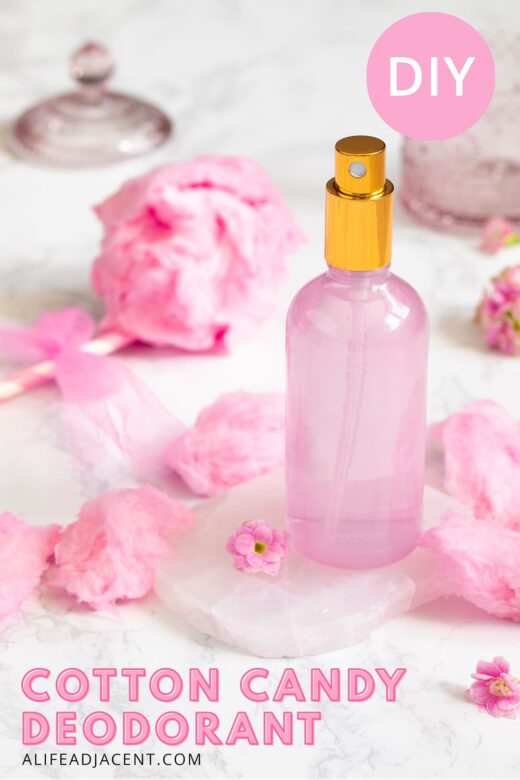
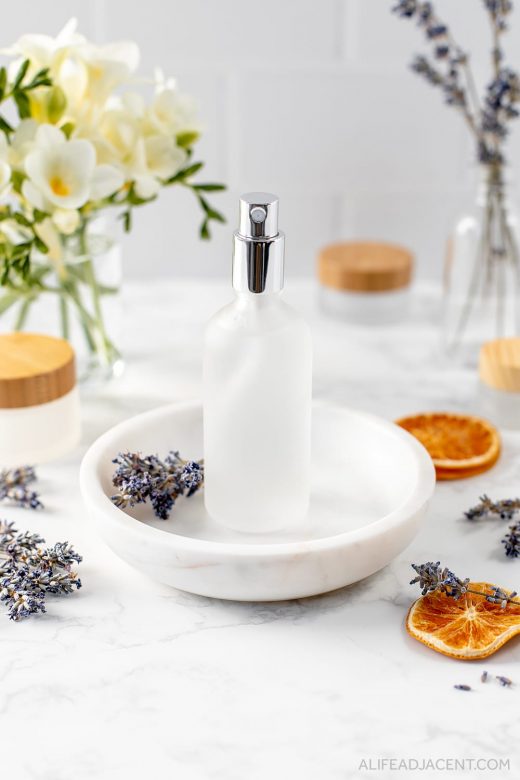
DIY Deodorant Spray Recipe
Ingredients
1/2 cup / 4oz high-proof alcohol (see recipe notes)
40 drops BO Be Gone essential oil blend (more blends above)
1 tsp vegetable glycerin
Optional ingredients
1 tsp apple cider vinegar
1/2 tsp essential oil solubilizer (see recipe notes)
Equipment
Amber glass spray bottle or frosted glass spray bottle (see recipe notes)
Small funnel
How to make deodorant spray with essential oils
- Clean equipment. Before making any homemade personal care products, you should start with clean, sanitized equipment. One way to do this is to wash everything with hot, soapy water. Then, sanitize with rubbing alcohol in a well-ventilated area.
- Combine alcohol and essential oils. Using a small funnel, combine the high-proof vodka (or grain alcohol) and essential oils in your glass spray bottle. Shake to combine.
- Add glycerin and ACV. Then, add the vegetable glycerin and apple cider vinegar.
- Shake to combine. Affix the spray nozzle and shake to disperse. Your essential oil deodorant spray is now ready to use.
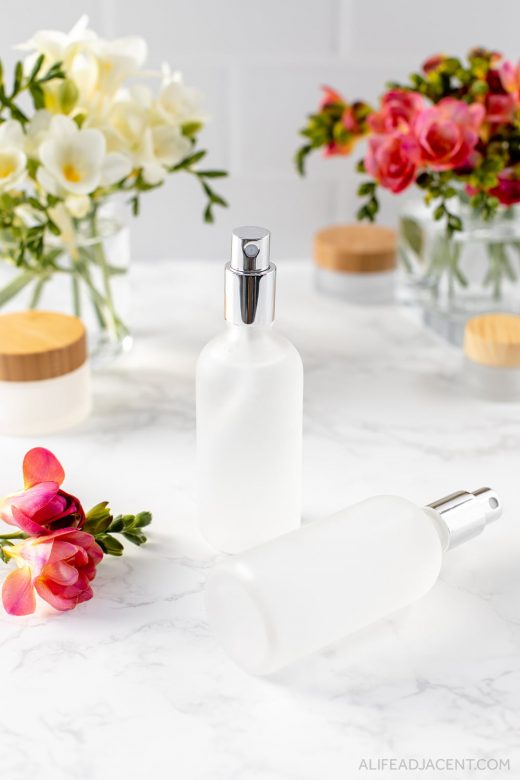
Recipe notes, tips & tricks
Deodorant spray storage and shelf life
- Ideally, you should store your liquid deodorant spray in a dark-coloured glass spray bottle. This helps protect the fragile essential oils from light. As well, please keep it in a cupboard or other dark area between uses.
- If you’d like to keep your deodorant in a clear or frosted glass bottle, just be sure to keep it protected from light while not in use.
- Please do not use a plastic spray bottle to store your deodorant, as essential oils are not compatible with plastic.
- Your deodorant should last 6-12 months. However, its exact shelf life will depend on the essential oils in your formula. Certain oils such as ylang-ylang and patchouli do not go bad, but others like lemon oil have short shelf lives and can be dangerous once expired. Read more about the dangers of expired essential oils.
- To ensure safety, please use only fresh essential oils. And if you used any citrus oils, please use your deodorant spray within 6 months.
How to solubilize essential oils
- If using regular vodka, you’ll need a natural fragrance solubilizer to properly disperse the essential oils in your deodorant spray, such as Poly Suga Mulse D9 or Caprylyl/Capryl Glucoside.
- To use, combine your essential oils and solubilizer in a small container such as a lab beaker. Mix to combine before adding to your vodka.
How to use your deodorant spray
There are a few different ways to use your essential oil deodorant spray. Whichever method you choose, be sure to shake well before each use to disperse the oils.
The simplest way to use it is to spritz onto clean, dry armpits and allow to dry. This may work well for you, but it will also depend on your activity level, your body’s unique microbiome and your sweat output.
On hot or strenuous days, you may need to reapply your liquid deodorant midday. Luckily, it’s portable and easy to apply on the go, especially if you put it in a tiny spray bottle. Reapplying also helps refresh your underarms and bolster your odor protection — an armpit perfume, if you will!
Another way to use this product is on top of another natural deodorant. Used this way, it acts as a booster that helps make your deodorant last longer.
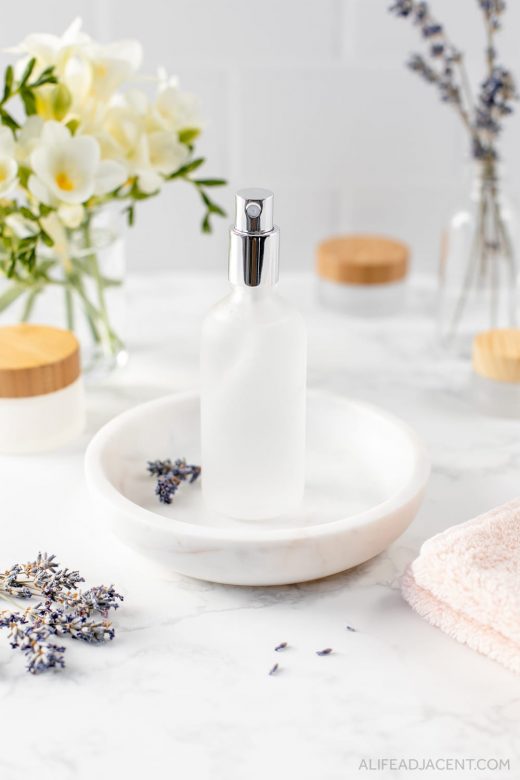
Additionally, if you’re in a pinch and find yourself hit with unexpected odor, you can use this DIY deodorant spray to do damage control. Chances are, it will get rid of smelly armpits fast and tide you over until a real shower.
Finally, remember that deodorant isn’t just limited to your underarms. You can also apply it to feet to prevent foot odor. Certain essential oils such as lemongrass and cedarwood have been shown to be effective specifically for smelly feet.
As well, this deodorant spray can also double as a light perfume or fragranced body spray.
DIY deodorant spray FAQ
How much essential oils to add to deodorant
Generally, when it comes to leave-on products like deodorant, a 2% essential oil dilution is considered safe for skin11. Whichever essential oils you choose for your deodorant spray, you should be careful not to exceed this level.
In a 4oz spray bottle, a 2% dilution is approximately 48 drops. However, I rounded down to 40 to further reduce the risk of skin irritation. Adding glycerin and vinegar dilutes the oils even more, so the final dilution ends up being under 2%.
However, using essential oils safely is not as simple as only using a certain number of drops – there are other factors to consider as well.
Are all essential oils good for armpits?
Not all essential oils are safe or good for your underarms. Some oils such as cinnamon should be avoided entirely.
As well, caution must be taken to verify each oil’s dermal maximum, as certain essential oils such as thyme, oregano and bergamot have lower recommended usage levels than the average.
For instance, bergamot’s recommended dermal limit is 0.4%. This means you should use no more than of 10 drops of bergamot oil in a 4oz deodorant spray (unless you are using bergapten-free bergamot oil, which is safe at higher levels).
Each of my essential oil blends takes usage levels into account. But if you choose to use an oil not included in my recipes, you should do your own research. Essential Oil Safety by Tisserand and Young is a great resource.
Also, please never apply undiluted essential oils to skin. Essential oils are incredibly potent and can cause skin irritation if used improperly.
I’ve seen people recommend applying pure tea tree or lemon essential oils to armpits to reduce sweating. These oils are useful when diluted, but can cause serious irritation when applied straight to underarms.
Can you use witch hazel as a substitute for alcohol?
No, witch hazel cannot be used as a substitute for alcohol.
Generally, witch hazel extracts are only 12-14% alcohol, which isn’t nearly enough to effectively kill armpit bacteria. As a result, alcohol based deodorants are much more effective than witch hazel deodorants.
Witch hazel also doesn’t contain enough alcohol to properly solubilize essential oils.
If you like witch hazel, there are many other ways to use it. It has soothing, anti-inflammatory effects that may work well for soothing irritated armpits, but I don’t recommend using it in a deodorant spray.
Is witch hazel a solubilizer?
No, witch hazel is not a solubilizer and cannot be used in place of alcohol. Witch hazel is an aqueous mixture of water, plant extracts and a small amount of alcohol. It does not posess any special properties that can solubilize essential oils.
Is vegetable glycerin an emulsifier?
No, glycerin is not a solubilizer or emulsifier, and it cannot solubilize essential oils. If glycerin had solubilizing or emulsifying properties, you could use it to mix water and oil. It simply doesn’t work.
Can you use rubbing alcohol as deodorant?
No, please do not use isopropyl alcohol as deodorant under any circumstances. Though it may work to kill odor-causing bacteria, it’s not safe to use in high quantities. Rubbing alcohol is not meant for prolonged or excessive topical use.
Is it safe to use rubbing alcohol as deodorant?
No – contrary to what some may say, rubbing alcohol is not safe for your underarms.
Isopropyl alcohol is readily absorbed through the skin. Prolonged skin exposure to rubbing alcohol can cause skin redness, rash, and extreme dryness and cracking12. It can also trigger allergic contact dermatitis13.
On the other hand, pure ethyl alcohol (like the kind found in vodka and grain alcohol) is safe for skin. Please do not use rubbing alcohol as a substitute for vodka.
Is this deodorant spray suitable for sensitive skin?
It’s important to note that this deodorant spray recipe may not be suitable for those with very sensitive skin.
It’s made without baking soda or magnesium oil, two ingredients frequently associated with skin irritation. However, it contains alcohol and essential oils. Both are irritants that can cause stinging, burning, and sensitivity in certain people.
Do not use this deodorant on inflamed, sensitive, or broken skin. As well, please do not use after shaving. If any irritation occurs, discontinue use. Skin sensitivities only get worse with repeated exposure.
If you have sensitive skin, stay tuned for my fragrance-free deodorant recipe without essential oils.

Homemade Deodorant Spray + Essential Oil Blends
Learn how to make your own DIY deodorant spray. This easy homemade recipe really works for smelly armpits! It contains alcohol and antibacterial essential oils to help get rid of body odor naturally.
Ingredients
- 1/2 cup / 4oz high-proof alcohol (see recipe notes)
- 40 drops BO Be Gone essential oil blend (more blends above)
- 1 tsp vegetable glycerin
- 1 tsp apple cider vinegar or white vinegar (optional)
- 1/2 tsp natural solubilizer such as Poly Suga Mulse D9 or Caprylyl/Capryl Glucoside (optional, see recipe notes)
Tools
- Glass spray bottle for storage, such as amber glass or frosted glass
- Small funnel
Instructions
- Before making any homemade personal care products, you should start with clean, sanitized equipment. One way to do this is to wash everything with hot, soapy water. Then, sanitize with rubbing alcohol in a well-ventilated area.
- Using a small funnel, combine the high-proof vodka (or grain alcohol) and essential oils in your glass spray bottle. Shake to combine.
- Then, add the vegetable glycerin and apple cider vinegar.
- Affix the spray nozzle and shake to disperse. Your DIY deodorant spray is now ready to use.
Notes
Storage and shelf life
- Ideally, you should store your liquid deodorant spray in a dark-coloured glass spray bottle. This helps protect the fragile essential oils from light. As well, please keep it in a cupboard or other dark area between uses.
- If you'd like to keep your deodorant in a clear or frosted glass bottle, just be sure to keep it protected from light between uses.
- Please do not use a plastic spray bottle to store your deodorant, as essential oils are not compatible with plastic.
- Your deodorant should last 6-12 months. However, its exact shelf life will depend on the essential oils in your formula. Certain oils such as ylang-ylang and patchouli do not go bad, but others like lemon oil have short shelf lives and can be dangerous once expired.
- To ensure safety, please use only fresh essential oils. And if you used any citrus oils, please use your deodorant spray within 6 months.
How to solubilize essential oils
- If using regular vodka, you'll need a fragrance solubilizer to properly disperse the essential oils in your deodorant spray, such as Poly Suga Mulse D9 or Caprylyl/Capryl Glucoside.
- To use, combine your essential oils and natural solubilizer in a small container such as a lab beaker. Mix to combine before adding to your vodka.
Recommended Products
As an Amazon Associate and member of other affiliate programs, we earn from qualifying purchases.
Pin it for later
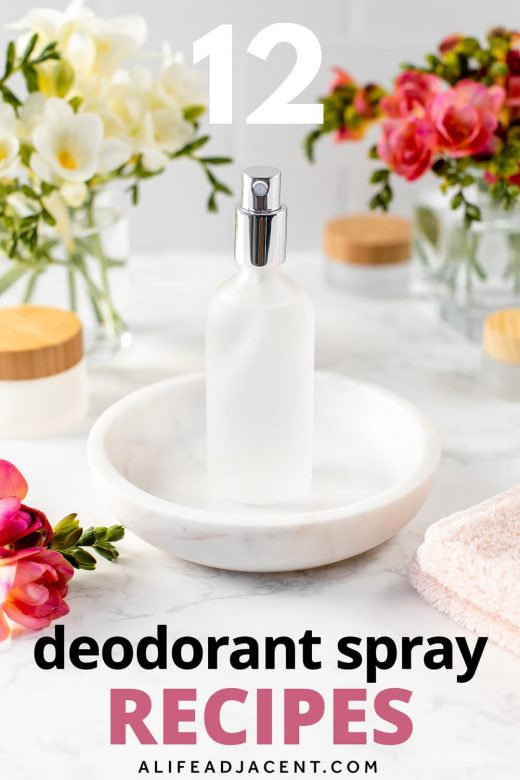
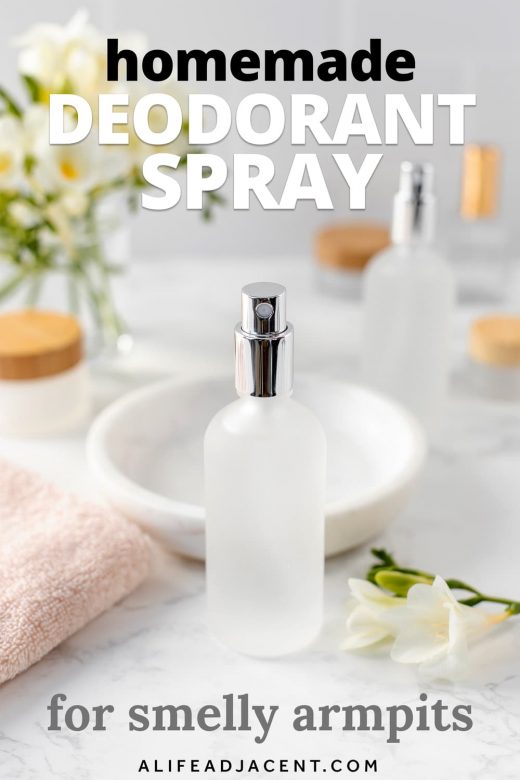
1. McGrath, K G. “An earlier age of breast cancer diagnosis related to more frequent use of antiperspirants/deodorants and underarm shaving.” European journal of cancer prevention : the official journal of the European Cancer Prevention Organisation (ECP) vol. 12,6 (2003): 479-85. doi:10.1097/00008469-200312000-00006
2. Minhas, Gurdeep S, et al. “Structural Basis of Malodour Precursor Transport in the Human Axilla.” ELife, ELife Sciences Publications, Ltd, 3 July 2018, elifesciences.org/articles/34995#metrics.
3. Kanlayavattanakul, M. and Lourith, N. (2011), Body malodours and their topical treatment agents. International Journal of Cosmetic Science, 33: 298-311. https://doi.org/10.1111/j.1468-2494.2011.00649.x
4. Kačániová, Miroslava et al. “Chemical Composition and Antimicrobial Activity of Selected Essential Oils against Staphylococcus spp.” Antibiotics (Basel, Switzerland) vol. 9,11 765. 31 Oct. 2020, doi:10.3390/antibiotics9110765
5. Orchard, A et al. “The in vitro antimicrobial evaluation of commercially essential oils and their combinations against acne.” International journal of cosmetic science, 10.1111/ics.12456. 24 Mar. 2018, doi:10.1111/ics.12456
6. Tadtong, Sarin et al. “Antimicrobial activity of blended essential oil preparation.” Natural product communications vol. 7,10 (2012): 1401-4.
7. Moy, Ronald L, and Corey Levenson. “Sandalwood Album Oil as a Botanical Therapeutic in Dermatology.” The Journal of clinical and aesthetic dermatologyvol. 10,10 (2017): 34-39.
8. Samaras, Yiannis & Chanioti, Marianthi & Koutroullis, G. & Tsiaousi, M. & Eriotou, Effimia. (2010). Antimicrobial Activity of Essential Oils on Staphylococcus sp.
9. Orchard, Ané, and Sandy van Vuuren. “Commercial Essential Oils as Potential Antimicrobials to Treat Skin Diseases.” Evidence-based complementary and alternative medicine : eCAM vol. 2017 (2017): 4517971. doi:10.1155/2017/4517971
10. Stenzaly-Achtert, S. & Schoelermann, Andrea & Schreiber, Joerg & Diec, K. & Rippke, Frank & Bielfeldt, Stephan. (2008). Axillary pH and influence of deodorants. Skin Research and Technology. 6. 87 – 91. 10.1034/j.1600-0846.2000.006002087.x.
11. “Guide to Diluting Essential Oils.” AromaWeb, www.aromaweb.com/articles/dilutingessentialoils.asp.
12. “The Dangers of Isopropyl Alcohol (IPA) – Flammability, Exposure, & Safety.” Production Automation Station, 9 Sept. 2020, blog.gotopac.com/2016/01/06/the-dangers-of-isopropyl-alcohol/.
13. García-Gavín, Juan et al. “Allergic contact dermatitis caused by isopropyl alcohol: a missed allergen?.” Contact dermatitis vol. 65,2 (2011): 101-6. doi:10.1111/j.1600-0536.2011.01936.x

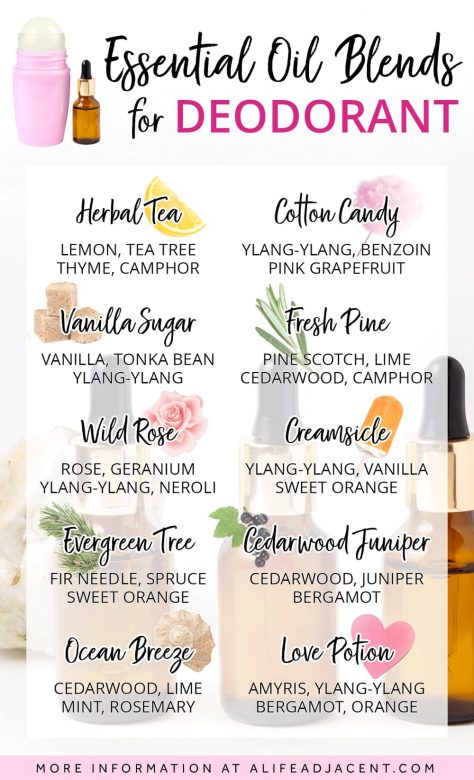

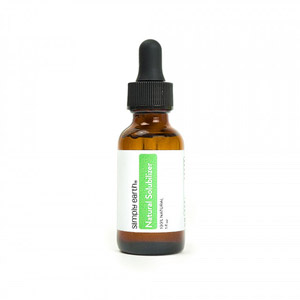




Damon
Sunday 30th of October 2022
I don't want to have alcohol in the house. Based on recovering alcoholic in the house. What can I use instead of vodka?
Kyla
Sunday 6th of November 2022
Hi Damon, sorry for the delay. You could replace the vodka in the deodorant spray with witch hazel – just please note that it may not be as effective. Witch hazel also doesn't contain enough alcohol to preserve the formula, so you'll need to add a natural preservative as well. LiNatural, Leucidal Liquid SF, or GeoGuard ECT are good options. I hope this helps!
Emily
Sunday 11th of September 2022
Made this recipe, but wanted to ask if I could put in an Amber glass jar with lid, to put cosmetic cotton pads for wipes. Is this going to ruin the efficacy?
Kyla
Tuesday 20th of September 2022
Hi Emily, absolutely! It won't affect the efficacy, but just be sure to keep the jar sanitary. I like to use my deodorant spray for wipes too – sometimes I'll just pour it onto a cotton pad. Hope this helps.
Yolanda Smith
Monday 19th of April 2021
So is it camphor or rosemary for the herbal tea formula??
Kyla
Tuesday 20th of April 2021
Hi Yolanda, the Herbal Tea recipe includes lemon, tea tree, rosemary, and thyme. 😊